Magic Seeds & the Miracle Crop
Air Date: Week of July 16, 2010
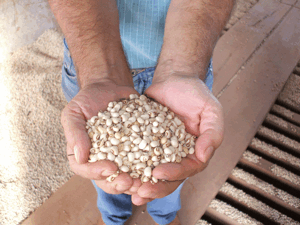
The transformation of Brazil scrub savannah into endless fields of soy is unprecedented. (Photo: Bruce Gellerman)
Brazil’s vast savannah has undergone the largest transformation of land in history. Modern science and shear luck have turned the region into a vast ocean of soybeans. Living on Earth’s Bruce Gellerman visited the central savannah to see if it’s environmentally sustainable.
Transcript
YOUNG: It’s Living on Earth, I’m Jeff Young. Agriculture experts call the soybean ‘a miracle crop.’ It’s used in thousands of products from tofu to bio-fuels. Most, goes to feed farm animals. The United States is the number one grower, but not for long. The soybean is booming in Brazil, where this year’s harvest was a record breaker. Market analysts expect Brazil will soon be the world’s leading producer. Just two generations ago, soybean farming on this scale in Brazil was unthinkable. Now, critics wonder if it’s unsustainable. Living on Earth’s Bruce Gellerman traveled to ‘ground zero’ of Brazil’s soy-revolution to find out.
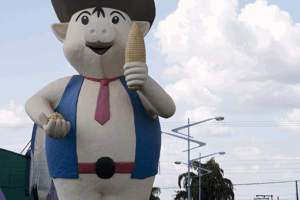
Porking out on Soy and Corn- A road side attraction in Mato Grosso. 85 percent of the world’s soy is used to feed farm animals. (Photo: Lauren Oakes)
[ROAD SOUNDS]
GELLERMAN: Mato Grosso is twice as large as California ….but there are only about half a dozen paved 2 lane highways in the entire state. Most roads are dark red dirt and deeply rutted… like this one, carved from the plateau frontier in the center of Brazil. This cerrado country.
[ROAD SFX]
GELLERMAN: In Portuguese ‘cerrado’ means “inaccessible” or “closed”…
LIMA: Here we have a typical cerrado vegetation, which is kind of a scrubland.
GELLERMAN: Biologist Marco Lima serves as guide and driver as we travel through this remote, rugged region.
LIMA: And you travel the next, at least, 12 hundred miles going north that’s the vegetation you’re going to find…
GELLERMAN: The cerrado is a tropical savanna - a complex mosaic of vegetation: closed canopy forests, vast grasslands and stunted, twisted trees…
[BIRDS, WATER]
GELLERMAN: But looks are deceiving… biologically, Brazil’s cerrado scrubland is the richest savanna on the planet…and, today, one of the most threatened. The ecosystem is home to ten thousand species of plants…half found only here. There are 200 species of mammals…and the place is a birder’s paradise…filled with macaws, parakeets, and vultures.
[BOATS ON WATER]
GELLERMAN: …and in the many Amazon River tributaries, marine life of all fin and stripe---peacock bass, pink river dolphins, and piranha. Half the year the forest’s torrential rains turn Mato Grosso’s dirt roads into red rivers of mud – the rest of the year, the land bakes in the tropical sun.
WARNKEN: The cerrado in its native state is extremely hostile
GELLERMAN: Phil Warnken literally wrote the book about farming in the cerrado. “The Development and Growth of Brazil’s Soybean Industry” is an oft-cited classic. Born and raised on a Kansas farm, Warnken was one of the first to investigate whether the ancient cerrado could be converted from scrub savannah into cropland.
WARNKEN: It was a wasteland, it was a giant wasteland…I first lived in Brazil in the mid 60’s… and was part of the study of the future potential of the cerrado. The conclusion of that team that was supported by the Rockefeller foundation…a first class blue ribbon team… the conclusion was that the cerrado had no potential for commercial agriculture. That was the mid 60’s.
[SOY TRUCKS ZOOM PAST]
GELLERMAN: Today, the sound of the BR 163 tells a different story.
[SOY TRUCKS ZOOM PAST]
GELLERMAN: The BR 163 – is better known as Brazil’s Soybean Highway. The two-lane road runs from Cuiabá- the capitol city in the center of Mato Gross 12-hundred miles north to a port on the Amazon. Much of the road is unpaved…and often impassable…but here its been surfaced,
LIMA: Trucks, trucks and Trucks.
GELLERMAN: Boy… they’re like mosquitoes you know…buzzzz
[SOY TRUCKS ZOOM PAST]
GELLERMAN: During the soybean harvest season 9 thousand trucks a day ---one every 6 seconds--- pass here, hauling soy from Brazil’s breadbasket to a world with a growing appetite for the oil and protein rich bean. Since 1985 global demand for soy has doubled and farmers in Mato Grosso have more than kept pace…soy output here has quadrupled.
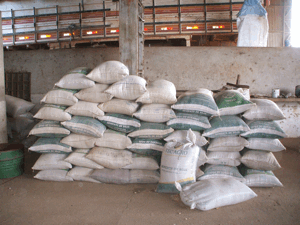
Sacks of Cerrado Soy- (Photo: Bobby Bascomb)
[TRUCK ZOOMS]
GELLERMAN: In less than 40 years Mato Grosso has undergone an agricultural revolution…the likes of which the world has never seen. The remote cerrado- once considered an agricultural wasteland- has been converted from scrub savanna into a vast ocean of soy, corn and cotton. It’s the result of a remarkable convergence of scientific breakthroughs, and shear luck. Again, soy expert Phil Wangren:
WANGREN: Several things happened and they all came together as what, I guess, one could call a positive perfect storm. And from then on, soybeans swept across the cerrado like wildfire.
GELLERMAN: The first thing that had to happen in order to grow the miracle soybean crop in this tropical climate was the development of what you might call a magic seed. For decades Brazilian and American scientists crossbred generations of soy plants before finally creating a seed that could thrive in the hot savanna. But the new seed also needed the right soil…the ancient cerrado soil is deep, which is great for soybean roots but over the ages torrential rains have worn and weathered the landscape.
WANGREN: Over the 50 million years, all of the soluble nutrients like nitrogen, calcium, magnesium have long, long ago been washed to the sea.
GELLERMAN: The cerrado soil was too acidic and loaded with toxic aluminum. And even the new soy seed couldn’t root in the poor soil. But then –says Phil Wangren, Brazil hit pay dirt.
WANGREN: There’s just unlimited limestone… it (laughs) would last for an eternity.
GELLERMAN: Miners found vast deposits of acid-neutralizing limestone….
[LIMESTONE …DRIVING BREAK….]
GELLERMAN: Conveniently located-- right in the middle of Mato Grosso.
[DOOR CLOSING, WIND]
GELLERMAN: Ooh it is dusty…look at that…the dust has covered…looks like snow!
[WIND]
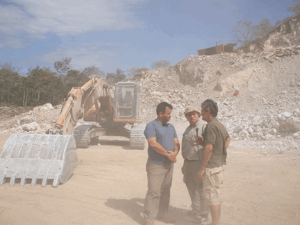
Limestone dust swirls as Marco and Bruce talk with mine manager Eugenio Kestingee. (Photo: Bobby Bascomb)
GELLERMAN: The wind, white and powdery- swirls at an open pit mine near the town of Cáceres- where a mountain of limestone was found on a hillside.
[MAN SPEAKING PORTUGUESE]
TRANSLATOR: This is the primary system.
GELLERMAN: Eugenio Kestingee, production manager of the mine…shows off the machinery:
[MAN SPEAKING PORTUGUESE]
TRANSLATOR: This is where we crush the stones.
GELLERMAN: Workers mine 800 tons of limestone a day here. At 10 dollars a ton, “It’s cheap,” says the manager.
[MAN SPEAKING PORTUGUESE]
TRANSLATOR: Yeah, here in the state of Mato Grosso, without the help of limestone, you wouldn’t be seeing so much agricultural production around.
[SOUNDS FROM OPEN AIR MINE]
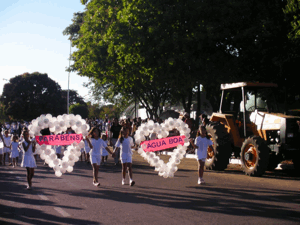
Everyone loves a parade as the the cerrado city celebrates its founding. (Photo: Bruce Gellerman)
GELLERMAN: Limestone turned the nutritionally poor land into soil suited for soybean. The discovery transformed the Cerrado, Mato Grosso, and Phil Wangren. He founded AgBrazil- advising investors from around the world interested in putting down roots in the dirt-cheap cerrado…. in what’s become know as “Soylandia.” Land speculators, squatters and settlers, also rushed in.
[AGUA BOA PARADE MUSIC]
GELLERMAN: Marching bands commemorate the founding of the city of Agua Boa, Mato Grosso. 30 years ago this was a frontier backwater - the entire county had a thousand people -today, the population has exploded 25-fold. Agua Boa-is a prosperous city boasting paved roads on the cutting edge of Brazil’s future. The mayor, Mauricio Tonha, says setters cleared the land of native vegetation and forests.
[MAN SPEAKING PORTUGUESE]
TRANSLATOR: Years ago, we slashed and burned the land. It wasn’t a lack of environmental concern. It was just the way things were done. We had no environmental guidance from the government.
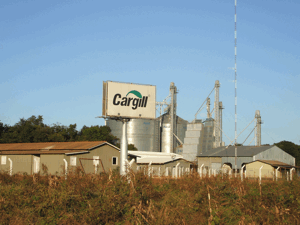
Cargil, MacDonalds and ADM are among the companies agreeing not to buy soy from deforested land in the Amazon. (Photo: Bruce Gellerman)
GELLERMAN: Brazil has some of the toughest environmental laws in the world but in this vast frontier, enforcement is weak…so non-governmental organizations have helped fill the void. Greenpeace recently renegotiated a 4-year-old moratorium with international soybean traders—who agree not to buy soybeans from newly deforested land in the Amazon. The deal has largely worked there. However, just south in the cerrado, deforestation has slowed, but continues. Nearly half-a million square miles of Mato Grosso’s cerrado have been slashed and burned.
[TRUCK SOUNDS]
CARTER: All this burned over here…see it’s all dead.
GELLERMAN: John Carter is head of an NGO that helps soy farmers preserve their forests while increasing profits. He drives us around his ranch in the remote northeast corner of Mato Grosso.
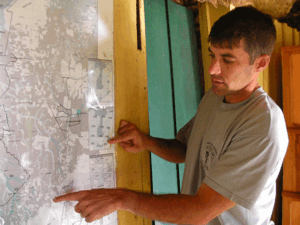
Texan John Carter staked his claim in Brazil’s cerrado frontier. (Photo: Bruce Gellerman)
CARTER: The fire blew through here, all that’s our forest reserve, it’s hard to tell from here- but that burned as well.
GELLERMAN: Carter is a transplanted Texan who came to the cerrado in the 1990’s seeking his fate and fortune. He was astonished at what he found.
CARTER: Fires in the U.S. you see on TV they’re a thousand acres and the world is screaming… and here we have hundreds of thousands of acres burning and no one says peep.
GELLERMAN: Scientists say the industrial scale slashing and burning of the region has released trillions of tons of forest carbon into the atmosphere and disrupted the region’s rain cycle…the cerrado is drying. Grassland fires that once could be contained now burn out of control. That’s why Carter, like other cerrado farmers is required by law to keep half his forest as reserve – so he’s re-growing 22 hundred acres of forest that burned down.
CARTER: This is five kilometers or three miles of straight lines that a tractor could drive to plant soybeans here. I let come back into compliance with the forest code, and that represents around 1.1 million dollars I threw away.
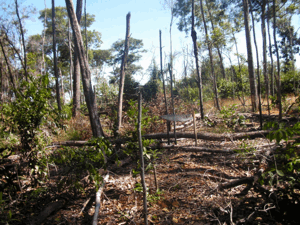
Scientists say industrial soy farming is changing the savanna climate and deforesting the landscape. (Photo: Bruce Gellerman)
GELLERMAN: Carter hopes to change the equation. His NGO Alianca da Terra shows farmers how to derive economic value from their standing forests. The Land Alliance helps farmers turn the carbon stored in their trees into credits companies can buy to offset their greenhouse gas emissions. Carlito Guimariz is a new member of Carter’s Land Alliance.
[GUIMARIZ UNFOLDING MAP]
[MAN SPEAKING PORTUGUESE]
TRANSLATOR: This is the county…
GELLERMAN: In these parts – Guimariz is known as the forest destroyer.
[MAN SPEAKING PORTUGUESE]
GELLERMAN: He opens a map…and points to his land…200 thousand acres… just south of the Amazon…on the Fontura River.
[MAN SPEAKING PORTUGUESE]
TRANSLATOR: I am on the Fontura River.
[MAN SPEAKING PORTUGUESE]
TRANSLATOR: That’s an area that was heavily deforested.
GELLERMAN: “The Forest Destroyer” says his reputation is well deserved --- he cleared and cut down a hundred thousand acres…and he makes no apologies.
BRUCE: I’m going to ask a not polite question… did you contribute to that deforestation.
[MAN SPEAKING PORTUGUESE]
TRANSLATOR: I did something conscience of what I was doing.
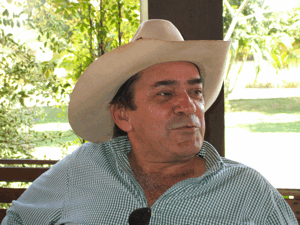
The Forest Destroyer- Carllito Guimariz. (Photo: Bruce Gellerman)
GELLERMAN: The forest destroyer now wants to be paid for keeping his remaining trees standing. There are no free lunches, he says… or breakfasts …or dinners…
[MAN SPEAKING PORTUGUESE]
TRANSLATOR: You see our world does not live without food. We could raise our productivity 3 or 4 times more…but, the thing is, will mankind be able to pay this price?
GELLERMAN: Cerrado farmers can boost their productivity, preserve their forests, and prevent green house gas emission…but the price is expensive. Intensive agricultural techniques and advanced technologies don’t come cheap and often there are steep, unintended, environmental costs and consequences.
[MAN SPEAKING PORTUGUESE]
TRANSLATOR: I have to show you this. This was sent me by John.
GELLERMAN: Farmer Jamar Bruenier is also a member of John Carter’s Aliance da Terra. The Alliance sent Bruenier a detailed report showing him how he can save bigbucks, or Brazilian reals, on expensive fertilizer.
[MAN SPEAKING PORTUGUESE]
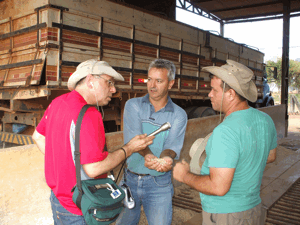
A Farmer Feeds the World- Soy farmer Jamar Bruenier being interviewed at his grain dryer. (Photo: Bobby Bascomb)
TRANSLATOR: Here you can see what is agriculture with precision…. This will show us the needs of the ground…per hectare…for example you can see the lack of potassium in this area which is the poorest area…Now we‘re putting the right doses that the ground needs and whatever there’s no need, we don’t put anything.
[WALKING TO GRAINERY SOUNDS]
GELLERMAN: To economize on fertilizer, prevent erosion and keep carbon locked in the soil , cerrado soy growers, like Bruenier, are encouraged to use the no-till farming method. Instead of tilling the land, they leave the remnants of the previous season on the ground to enrich the soil. But bugs feast on past harvests and no till has led to a 3-fold increase in pesticide sales in just 6 years. Today Brazil is the largest user of pesticides in the world. Professor Alexandre Ultramari studies the use of agricultural pesticides at the State University of Mato Grosso. He says, over the past generation, cases of cancer have doubled in Mato Grosso compared to the rest of Brazil…and birth defects have tripled.
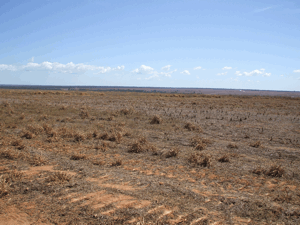
After the Harvest- Cerrado farmers are encouraged to use the no-till farming method. (Photo: Bruce Gellerman)
[MAN SPEAKING PORTUGUESE]
TRANSLATOR: Basically when you talk about the cancers, what do you see? You see people especially with cancers on their digestive systems…for example the intestines, ok. And also when you talk about malformations, at the University hospital here, we’ve been seeing lots of children with malformations like… born without legs, arms, hands. Many different malformations- no legs, no arms- even brainless.
BRUCE: You think it’s from these agro-toxins?
[MAN SPEAKING PORTUGUESE]
TRANSLATOR: You know, I’m not going to say all- 100 percent of the cases will be- but definitely a big, big, major piece of this, yes.
[VIDEO: “OWNERS OF THE WATER:” BABY CRIES, WATER SPLASHING]
GELLERMAN: Many of those cases can be found among indigenous people in the cerrado. In 2006 members of the Xavante tribe blocked a bridge –preventing soy trucks from crossing the Rio das Mortes…The River of Death.
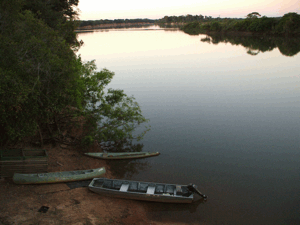
Boats on the River of Death- Members of the Xavante tribe say pesticides from soy fields are polluting their river. (Photo: Bruce Gellerman)
[CHATTING]
GELLERMAN: It was a tense, but peaceful, one-day protest… against industrial soy farmers in the area. The Xavante charge the pesticides used on soy fields were running onto tribal lands and into the River of Death. A video, “Owners of the Water” documents the demonstration…and damage to the environment.
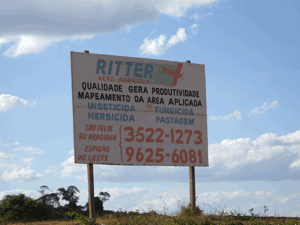
Advertising Pesticides- The sale of pesticides in Brazil is booming. (Photo: Bobby Bascomb)
FEMALE VOICE: Women from all Xavante communities are noticing so much pollution in the river! It’s really bad. This pollution is destroying the water we use for cooking.
GELLERMAN: If the River of Death dies…say the Xavante…we all die. The Xavante aren’t the only ones protesting …in 2004 China- Brazil’s largest customer for soybeans- temporarily suspended shipments, charging they were contaminated with dangerous levels of banned pesticides.
[MONSANTO AD]
GELLERMAN: So once again, Brazilian farmers turned to agricultural science, and the promise of a new soy seed…
[MONSANTO AD]: But those who say it’s not good for the environment, I’d say we should use biotechnology even more….
GELLERMAN: Until 2004 it was illegal to sell genetically modified soybean seed in Brazil, but today, companies like Syngenta and Monsanto advertises heavily in Mato Grosso farm country. Monsanto has engineered a seed designed to grow even when dosed with their pesticide: Round Up. Monsanto calls the transgenic seed: Round Up Ready…and claims the pesticide is safe. Soy farmer Jamar Bruenier recently switched to the new biotech seed.
[MAN SPEAKING PORTUGUESE]
GELLERMAN: How does it work for you, good?
[MAN SPEAKING PORTUGUESE: MUCHO BIEN…]
TRANSLATOR: Through research we’ve done, the transgenic agriculture is going to be cleaner because we’re going to be using much less pesticides…so it’s going to be, just better… It’s going to be way less contamination in the ground and in the waters, in the water systems.
GELLERMAN: The seed will cost him more.
TRANSLATOR: But you see it will cost much cheaper because the royalties we’ll pay to Monsanto is way cheaper than what the pesticides costs.
GELLERMAN: That’s in the short term. But increasingly soy farmers are disappointed with yields from genetically modified seeds. New super-weeds that are resistant to Round Up are growing on their fields. So Monsanto has created yet another generation of biotech seed: Round up Ready 2, which can tolerate even stronger doses of pesticide.
[REBUILDING ROADS]
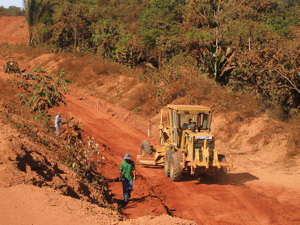
Paving a way to the Future- Mato Grosso is nearly twice the size of California but has just a handful of paved highways. (Photo: Bruce Gellerman)
GELLERMAN: A road grater repairs a soy highway washed out by torrential rains. Brazil is rapidly paving a path through the cerrado frontier to it’s future. The government recently launched ‘The Accelerated Growth Program’…to speed soy to market- it’s spending tens of billions of dollars on new roads and freight trains. China is also paying to construct a road over the Andes to take soy from the cerrado to ports on the Pacific. It’s an ambitious, audacious program that will be needed to keep pace with Brazil’s plan to increase soy production by 50 percent in the coming decade. Again, Phil Warnken of AgBrazil.
WARNKEN: Brazil has a massive, massive frontier that remains to be opened. Brazil can open more land, than the United States has under production at the current time. In the future, Brazil will be the super-power of agriculture. And, it already is right now. Brazil is the superpower of world agriculture.
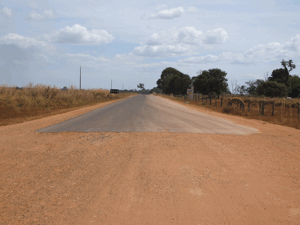
Paved roads speed soy to market and open up new land for farming. (Photo: Bruce Gellerman)
[BIRDS CHIRPING]
GELLERMAN: For five centuries colonial exploiters and new world explorers came to Brazil’s cerrado searching for lost cities of gold. But, today, in the harsh frontier of Mato Grosso it’s green gold that the world seeks…fields of soybean that only seem to go on forever…in what is left of the biologically richest savanna on the planet. For Living on Earth I’m Bruce Gellerman.
[MUSIC]: Thievery Corporation “Samba Tranquile” from The Mirror Conspiracy (ESL Music 2000).
YOUNG: LOE’s Bobby Bascomb helped produce our story. For pictures and more visit our website LOE dot ORG. Coming up: we heard about the seaweed of the Sargasso – now the story of the plastics in the Sargasso trash - That’s just ahead on Living on Earth.
Links
A Worldwatch Institute report on soy traders agreement to protect Amazon, but not the Cerrado
Living on Earth wants to hear from you!
Living on Earth
62 Calef Highway, Suite 212
Lee, NH 03861
Telephone: 617-287-4121
E-mail: comments@loe.org
Newsletter [Click here]
Donate to Living on Earth!
Living on Earth is an independent media program and relies entirely on contributions from listeners and institutions supporting public service. Please donate now to preserve an independent environmental voice.
NewsletterLiving on Earth offers a weekly delivery of the show's rundown to your mailbox. Sign up for our newsletter today!
 Sailors For The Sea: Be the change you want to sea.
Sailors For The Sea: Be the change you want to sea.
 The Grantham Foundation for the Protection of the Environment: Committed to protecting and improving the health of the global environment.
The Grantham Foundation for the Protection of the Environment: Committed to protecting and improving the health of the global environment.
 Contribute to Living on Earth and receive, as our gift to you, an archival print of one of Mark Seth Lender's extraordinary wildlife photographs. Follow the link to see Mark's current collection of photographs.
Contribute to Living on Earth and receive, as our gift to you, an archival print of one of Mark Seth Lender's extraordinary wildlife photographs. Follow the link to see Mark's current collection of photographs.
 Buy a signed copy of Mark Seth Lender's book Smeagull the Seagull & support Living on Earth
Buy a signed copy of Mark Seth Lender's book Smeagull the Seagull & support Living on Earth

